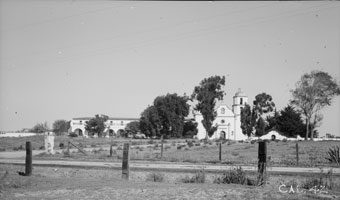






The Church was started in 1798 and finished in 1802. Other buildings went up quickly with the help of the Native workers. By 1804 all of the buildings in the quadrangle were finished. The Mission grew and a larger church was ordered to be built. The second church was finished in 1815 and held 1000 people.

Those that lived at the Mission went by a strict schedule. The Fathers were used to this type of lifestyle, but the neophytes were not. The structure of Mission life was one of the reasons many Native Californians tried to leave. A French explorer, Jean François de La Pérouse, visited Mission San Carlos is 1786 and wrote a detailed account of what he observed. Events at the Mission were signaled by the ringing of the Mission bells. Each day started around sunrise (about 6am). The Mission bells would ring to wake everyone and summon them to Mass and morning prayers. Prayer lasted for about an hour and then everyone would go to breakfast. Atole, a type of soup made from barley and other grains, would be served. Breakfast took about 45 minutes and then it was time for everyone to go to work.
The Fathers were responsible for running the Mission and instructing the new converts and children in the Catholic faith. Most of the men went to the fields to tend to the crops or to help with the animals while women stayed at the Mission and worked on domestic chores such as weaving cloth and making clothes, boiling down fat to make soap and candles, and tending to the vegetable gardens. Children often helped at these chores around the Mission once their religious instruction was over. Depending on the particular industry at the Mission there also might be neophytes leatherworking, metalworking, wine making, and pressing olives for olive oil.
At noon the bells would ring again for everyone to gather for dinner, what we would call lunch. Lunch was normally pozole, another thick soup with beans and peas. After an afternoon break everyone returned to their work for another two to four hours depending on how much work there was to be done. A last bell would be rung to end the work day. Another serving of Atole would be served and the neophytes would be able to rest until it was time for bed (Margolin, Pg. 85). Women were usually expected to go to bed by 8pm and men by 9pm. Most of the Fathers allowed their neophytes to continue to hunt and gather additional foods and to cook some of their traditional dishes.
Living at the Mission was often difficult for new converts. They were used to working when work needed to be done and resting when they were tired. The Mission lifestyle was different. The Neophytes were the main source of labor for the Missions. It was their hard work along with the soldiers’ and Fathers’ that built the Missions and their outbuildings. Agriculture and ranching required constant tending to the crops and animals. Without this labor the Missions would not have been able to survive. Many neophytes missed the freedom of their tribal life and would try to leave the Mission. The Fathers wouldn’t allow neophytes to leave and would send soldiers to search for them and bring them back. Runaways were usually punished for breaking the rules.
The soil around the Mission was able to support a number of different crops including oranges, grapes, wheat, and hemp. Hemp was used to make string, rope, and clothing. The Mission also had room for cattle, sheep, and hogs. By 1831 there were 2800 neophytes living at the Mission. Mission San Luis Rey had the largest number of Native Californian converts in the entire Mission chain.


 In 1893 restoration efforts began. The Mission was repaired by Father. Joseph Jeremiah O’Keefe and rededicated May 12, 1893. A smaller quadrangle was completed by 1905. Restoration continued over the years and the mission was featured in a film “The Pride of Palomar” from the 1930s and a television show, Zorro, filmed there in 1957. The Mission was made a national historic landmark in 1970.
In 1893 restoration efforts began. The Mission was repaired by Father. Joseph Jeremiah O’Keefe and rededicated May 12, 1893. A smaller quadrangle was completed by 1905. Restoration continued over the years and the mission was featured in a film “The Pride of Palomar” from the 1930s and a television show, Zorro, filmed there in 1957. The Mission was made a national historic landmark in 1970.
- The Author’s Name: Tricia Weber
- The Title of the Page: (Look at the banner at the top of the page.)
- The Date the Page was Last Updated: August 18, 2006
- The URL(Web Address) of the Page: (Look in the Address Bar at the top of the page.)
- The Date you Visited the Page: Use today’s date.